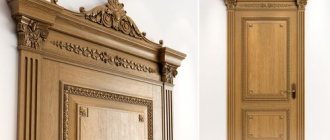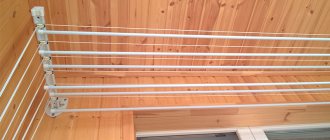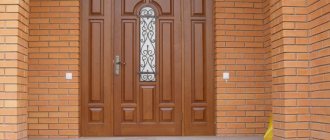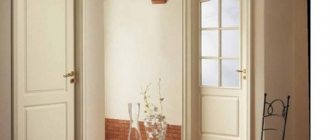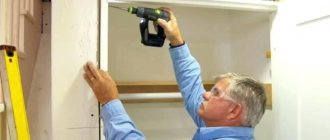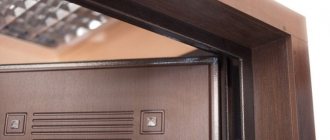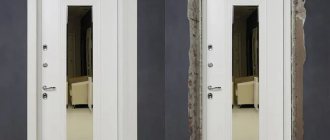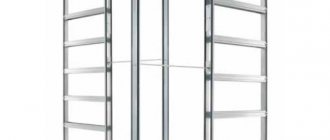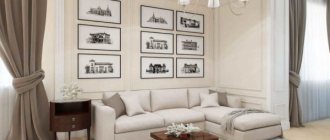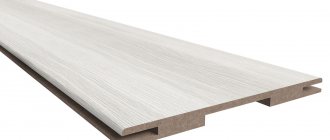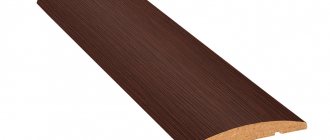The surrounding interior has a strong influence on the psychological comfort and well-being of people. That is why, when decorating and renovating residential and commercial premises, owners pay special attention to their design. They carefully select color shades, decorative items and general style. Sometimes it is enough to decorate a wall with a colorful panel or place a beautiful ceramic vase on a shelf to give the room life and a special mood.
Door capital in antique style
Modern industry provides many opportunities for creating a unique interior in a home, institution or office of a reputable company. One of the most successful, expressive solutions are capitals for doors. They allow you to give rooms or an entrance area a special flavor without any special financial costs, and successfully emphasize the chosen interior style.
Interior doors with a capital in a classic interior
Our designers talk about what capitals are, what they are like and how to use them.
Capitals for doors: what are they?
Capitals are a legacy of ancient times. The name comes from the Latin word “capitellum”, which translates as “head, crown”. In ancient architecture, this was the name given to the upper part of a column or pilaster, crowning it. Most often, it was made in the form of three-dimensional geometric shapes, papyrus buds or stylized flowers, palm leaves.
The capitals were covered with fancy three-dimensional patterns, painted in different colors, and decorated with metals and stones. Decorative crowns, as a rule, were larger than the column base, protruding beyond its limits. Thus, they provided a smooth, natural transition to the horizontal structural element - the entablature or abacus.
In the modern sense, a capital is a decorative element used to decorate the upper part of a doorway.
Door capital in antique style
The detail owes its origin to ancient architects, who crowned columns with it to ensure a smooth flow of the upper base of the structure into the square abacus.
The capital can be divided into three components:
- abacus, that is, a square tile with a heel and a shelf at the top edge;
- echin, namely a connecting element of three belts and necks;
- astragalus, which is a protruding roller with a shelf, which is attached to the column trunk with the help of fillets.
For clarity, you can imagine the elements of the capital in the form of the following geometric figures:
- column - cylinder;
- abaca – square slab;
- echin – fourth shaft;
- astragalus - circle.
Interior doors with classic capitals
Approximately, these architectural structures appeared in the 16th-15th centuries BC. In subsequent centuries, the elements of the entrance groups were improved, they included new stylistic and structural solutions.
In modern architecture, capitals decorate the entrance groups of cultural objects (theatres, cinemas, museums), government institutions, and universities.
Capital for interior door made of carved oak
They are readily used by private individuals in the construction of their houses and the design of apartments. Entrance or interior doors with a capital look especially representative and create an atmosphere of solemnity and well-being.
Material matters
The choice of decorative elements for the door depends on financial capabilities and personal ideas about beauty. It doesn’t matter what the customer prefers - smooth curls, voluminous floral motifs or antique ornaments.
The main rule is that the material used to make the door structure and its decorative elements must be the same. Solid wood is not compatible with PVC, polyurethane and other artificial materials - they visually reduce the cost of the structure.
Over time, synthetic raw materials can crack, deform and change color. A door framed like this will look unattractive. Compromises and combinatorics of materials of different origins are inappropriate.
What are door capitals used for?
In past centuries, magnificent, luxurious entrances were the prerogative of palaces, mansions of the highest aristocracy and the wealthiest people. That is why this type of decor is firmly associated with an excellent financial position, prosperity, and exquisite interiors.
Until the 50s of the last century, capitals decorated all significant public buildings, government dachas and other respectable objects. In modern society, the part is assigned the same functions.
The presence of a capital above the front door emphasizes the high status and financial prosperity of the homeowners, as well as their refined aristocratic taste. The capital can be used to decorate an entrance or interior door or to decorate an arched opening.
When minimalist trends replaced classical styles, capitals went out of fashion, as they seemed too pretentious, “philistine”.
Interior doors with capitals
But fashion is changeable, and progress does not stand still. In the 90s, in the wake of the discovery of new finishing materials, interior designers offered innovative solutions for antique door decor.
- The style has changed, becoming more strict and laconic. At the same time, manufacturers do not discard antique-style designs. Today it is not difficult to choose a suitable solution for both baroque and high-tech interiors.
- Lightweight, durable and undemanding materials have won the hearts of consumers. Today there is no need to carefully care for capricious wood, or take into account the considerable weight of marble slabs. You just need to choose a model from a material suitable for a specific situation. So, for thin walls, plasterboard and wooden partitions, products made of plastic, foam plastic, and MDF are suitable.
- The structures are installed in a matter of minutes and captivate with their magnificent appearance, which is preserved for many years.
Door capital made of solid oak
The first installation option involves placing the capital above the top bar, while the side trims will serve as improvised columns. Thus, the door takes on a solid and presentable appearance.
Despite the fact that the capital is an independent element of decoration, very often it is already equipped as an addition to the door structure. The decorative element is mainly installed from the front entrance. The set may also include a cornice, and if there is none, the capital emphasizes the isolation of the columns (platbands).
Capital for a door with columns
Jumpers resembling side trims are used as adapters between the door and the capital. Sometimes owners use capitals as cornices.
In the last two decades, capitals have again become a popular interior and facade solution. They are readily used to frame doorways, arched passages, and entrance lobbies.
Entrance door with capital
Scheme of attaching an aluminum rail to the canvas
Installing an aluminum rail or panel will not take much time. To ensure the installation is successful, do the following:
- First of all, after selecting the capital, it is necessary to cut the aluminum or plastic slats and panels to the required length. To do this, the top rail or panel above the door leaf is first installed, but there is no need to finally fix the element. Marks are placed on the panel or aluminum strip for further cutting.
Attaching an aluminum strip to the ceiling
- The next step is the actual installation of the aluminum panel.
- The slats themselves are attached using additional sizing foam, which is applied lengthwise to the door leaf. This is done in small strokes.
- Next, the lower groove is installed on the door leaf. A part of an aluminum strip is inserted into it, which is adjacent to the floor. However, this panel should not be glued to the door leaf. But the main part of the capital must be firmly inserted into the groove, then pressed and secured with foam.
- At the end of the installation of the structure, the rail should be attached to the side using an additional piece.
Installation of slatted aluminum capital under the ceiling
After completing the installation, you need to let the foam become solid, and then check the installed slats or panels for strength.
Results
Modern interior doors with capitals are an attractive decorative element for framing the door leaf. Previously, columns were used for a similar purpose. But due to their bulkiness, massive structures were replaced by flat slats and panels. Interior passages with capitals look attractive, neat and fashionable.
Voted over 177 times, average rating 4.4
Comments
Unfortunately, there are no comments or reviews yet, but you can leave your...
Add a comment Cancel reply
We recommend reading
Miscellaneous Options for insulating a wooden entrance door with your own hands Owners of private houses are concerned with the question of how to insulate the entrance ...
Miscellaneous How to get neighbors' agreement to move the front door to an apartment? Sometimes remodeling an apartment requires some changes in...
Miscellaneous How to properly install an entrance door in aerated concrete? New types of cellular concrete: gas and foam concrete are replacing the usual...
Miscellaneous What is the best way to install an interior door without a threshold? When the moment comes that you have to change interior doors...
Advantages of high-quality capitals for doors
Good capitals not only complement the interior, but also have a number of advantages, including:
- grace;
- conciseness;
- environmental Safety;
- hypoallergenic and antistatic properties;
- fire resistance;
- simple installation;
- unpretentious care.
Interior door with ridge capital
By purchasing a capital, you acquire an ergonomic stylistic solution that can emphasize the sophistication, exclusivity and luxury of your interior.
Design features of the door capital
As in ancient times, any modern door capital consists of three elements:
- abacus
- a horizontal piece in the form of a thick slab of square, rectangular or complex shape. It is crowned with a heel and a shelf protruding forward. Previously, the abacus had a practical function, as a support plate that transferred the weight of the floors and pediment to the columns. Today, abaci for interior doors are a purely decorative element that can even be made of polyurethane;
- echinus
– transitional part from the abacus to the column trunk. Traditionally it had a rounded shape in the form of a sea urchin shell, with three belts and a neck. Since modern designs are not designed for heavy loads, this element has become more decorative, sophisticated, and the variety of design solutions is admirable;
- astragalus
(or “cervical vertebra” translated from Greek) is a protruding cushion with a shelf. It is connected to the column by fillets.
Capital elements for entrance and interior doors
The entire structure rests on two columns (or platbands). At the top they are decorated with rosettes, and at the base there are foot-bearing plinths. Depending on the design, the supporting elements can be flat, semicircular, with longitudinal relief, or figured, with a variety of carvings.
Rosettes and boots
An elegant decorative element for decorating a door is a rosette. It organically masks the joint of the platbands, which are cut at a right angle. Covered with intricate carvings, decorative rosettes for the door complete the image of the structure.
The door frame frames the casing from below, in tandem with the rosette, highlighting it and completing the image of the column.
In classic interiors, these elements match the color of the solid wood paneling. In recent years, the tendency to mount rosettes and boots in a contrasting shade has been gaining popularity. Such a bold design decision requires a balanced approach and is appropriate for a living space that is not overloaded with furnishings.
All models presented in the Door Loft catalog of interior doors are available with a cornice, boot and rosette in any combination.
What types of door capitals are there?
Based on structural and design solutions, capitals are divided into several main groups:
- cornice - with laconic, geometric shapes;
- wave - with the image of a relief elongated-rounded pattern;
- crown - with a semicircular cutout in the center of the capital;
- romance - with an abacus of a complex, arched or pyramidal shape;
- elevation - with vertical relief lines, strictly rectangular in shape;
- mixed - incorporating the most successful elements of all traditional designs.
At the same time, the groups themselves consist of a huge assortment of traditional models, unique proprietary solutions, and proprietary developments of well-known manufacturing companies. Thanks to such abundance, choosing the ideal option for a specific room (or corridor) is not difficult.
Door capital with a beautiful pattern
What is a telescopic casing?
Telescopic platbands are visually similar to regular ones, but such a platband has a protrusion (quarter), no more than two centimeters, for connection with the door frame or extensions. They already have a groove made for joining into a single structure. Many people believe that a telescopic frame is better than a regular one. Of course, but only if the technician installs it efficiently. But if he incorrectly calculates the distance and the platband does not go completely into the box and there remains a gap of at least 1 mm, such a design will not look beautiful. A regular casing “forces” the craftsman to bring the edges flush, which eliminates the need to rely on a groove, like with “telescopes”. In this case, there will definitely be no gap. And so, of course, it’s up to you to decide which design and fastening of the casing to use: telescopic or conventional.
What materials are door capitals made from?
Capitals for doors differ in the materials from which they are made. The most expensive are products made from valuable wood and metal, and natural stone. Polymer structures, models made of veneered or laminated MDF with milling are budget options.
- MDF.
In terms of beauty and aesthetic characteristics, these models are not inferior to products made from natural wood. But their cost and performance characteristics are encouraging. MDF is undemanding to care, does not crack and is not afraid of moisture, is durable, and retains its magnificent appearance for years.
MDF door capital
- Solid wood.
Traditional material for interior spaces. It is distinguished by its strength, durability, high environmental friendliness and “rich” appearance. As a rule, such capitals are decorated with elaborate carvings, complex volumetric details, and floral and ethnic ornaments.
Solid wood door capital
- Polymer structures
are made from polyurethane, polystyrene foam, and hard plastics. They are light in weight, so they do not load the walls; they can simply be glued to the surface. They are not afraid of moisture and are extremely easy to care for. However, they do not withstand chemical and mechanical influences, quickly losing their ceremonial appearance.
Door capital made of polymer
- Metal capitals
are installed above steel entrance doors. They have a high degree of strength and vandal resistance. Unlike wooden products, their coating perfectly withstands the effects of rain, snow, and is easily cleaned from dust and dirt.
Metal capital for steel entrance doors
- Natural stone capitals
are made for entrances to various institutions, commercial and government enterprises, and organizations. However, if you have the desire and the means, you can order a capital in an exclusive design for a private house or apartment. It must be remembered that stone slabs have significant weight and require a solid base and good fastenings.
Limestone entrance capital
Also, for interior spaces in a classical style, capitals are made of gypsum, complete with false half-columns and other elements of decorative wall and ceiling decor.
Mounting options
There are several technologies for fastening capitals. It is worth considering each of them in detail:
- The device is based on additional elements. What is remarkable about installing the structure in this way? The capitals are fixed to the frame with nails, so installation is simple and does not take much time. Designers do not recommend such installation due to the lack of an aesthetic component. This method is provided by manufacturers who make extensions with a groove for a special comb located on a telescopic platband. At the same time, the installation technology is considered the most reliable.
- Installation by pre-milling the capital strip: the hole is made so that the product can be inserted into the groove.
Slatted wooden element for the ceiling
The milling stage itself is simple. It is enough to take the tool and walk along the length of the panel several times. In this case, it is worth periodically checking the width of the resulting recess. After this, the additional device should be pushed tightly into the groove of the rail. Installation of the element is not included in the cost of the manufacturer's service. Therefore, you should either call a specialist, or learn how to install the capital slats yourself.
